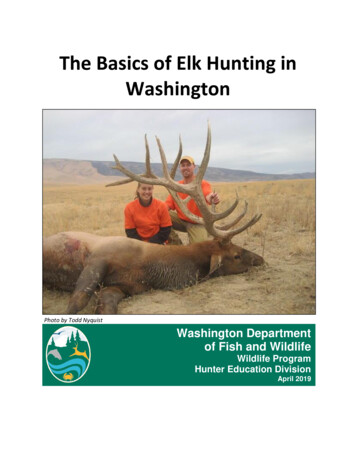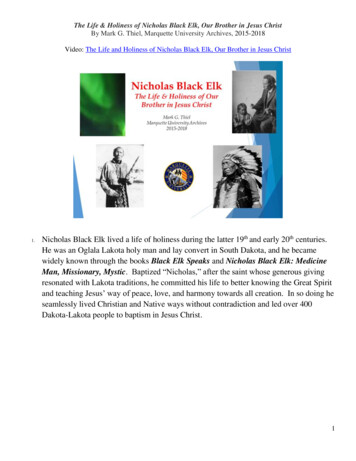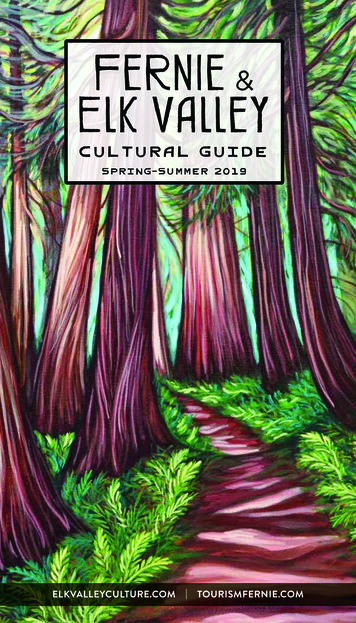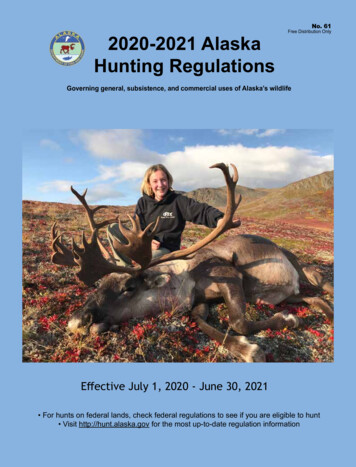
Transcription
The Basics of Elk Hunting inWashingtonPhoto by Todd NyquistWashington Departmentof Fish and WildlifeWildlife ProgramHunter Education DivisionApril 2019
(This page intentionally left blank.)2
Table of ContentsIntroduction . 5License and Tag Choices . 6Elk Species. 7Roosevelt Elk . 7Rocky Mountain Elk . 8General Elk Information . 9Food and Feeding Habits . 9Tracks. 10Droppings . 10Wallow Sites . 10Bedding areas . 11Rubs . 11General Elk Hunting Techniques . 11Hunting Equipment. 12Archery equipment . 12Muzzleloader equipment . 14Modern Firearm Equipment . 16Clothing and Concealment . 18Knives . 20Optics. 21Calls to use . 21Where to Go . 22Hunting Ethics . 23Shot placement . 23Broadside. 24Quartering away . 24Quartering to . 24Head on . 24Rear end . 25Tracking. 25Tagging . 26Field Dressing . 26Skinning. 27Processing . 28Elk Hoof Disease in Southwest Washington . 28Hunter Reporting . 28NOTES . 30Ten Basic Safety Rules . 313
The information contained in this manual was collected from the WashingtonDepartment of Fish and Wildlife website (wdfw.wa.gov) and its employeesunless otherwise cited. (2016)4
IntroductionWelcome to elk hunting! This course should provide you with basic knowledge about elkhunting in Washington State and give you a general guide to be successful. It should also serveto help you in your hunting pursuits.In our Basic Hunter Education course, we teach students how to hunt safely. This course isdesigned to give you an overview of the biology and habits of Washington’s elk species and howto hunt them effectively. This guide will also help teach you about game handling, huntingequipment regulations and choices, correct shot placement, hunter reporting, and much more.These topics will help you become more knowledgeable as a hunter and make the animals youharvest become great table fare.One thing to remember when pursuing any animal is that it is called hunting for a reason. Youmay not be successful in harvesting an animal every day, or every season. That’s part of theenduring challenge and fun of hunting. Each season brings a new opportunity to hone yourskills. To properly set your expectations, check the annual harvest statistics, which are postedon the WDFW website at t.For most of us, hunting is about much more than a successful harvest. It’s about spending timeafield bonding with family and friends, watching the sunrise over the mountains on a crisp fallmorning, and having exciting stories to tell when you get home.Photos by WDFW5
License and Tag ChoicesWDFW offers many different licenses that allow you to elk in Washington. Unlike many otherstates, Washington offers species-specific big game licenses that include a transport tag in thecost of the license. This system allows you the flexibility to buy each species option individually,or receive discounts if you buy a bundled multi-species package (see below for an example ofbig game license packages). You can also receive a discount if you purchase your small gamelicense and a big game license together. Remember that you will not receive the discountunless the license items are purchased at the same time.The licenses listed below are available for purchase by any hunter over-the-counter and giveyou the ability to hunt during the general hunting season.The general season big game license choices are as follows: Deer, Elk, Bear, and Cougar License Deer, Elk, Bear, and Cougar License W/discounted Small game Deer and Elk License Deer and Elk License W/discounted Small game license Deer License Deer License W/discounted Small game license Elk License Elk License W/discounted Small game license Bear License Bear License W/discounted Small game license Cougar License Cougar License W/discounted Small game licenseBig game licenses are issued based on species option, but transport tags are more specific. Forelk, you must declare a weapon type (archery, muzzleloader, or modern firearm) and area(eastern or western Washington) to receive your transport tag. If you haven’t decided on aweapon type or area when you buy your license(s), you can choose to have your tag printedlater, but make sure you get your tag before you hunt.Elk can be hunted with archery, muzzleloader, or modern firearm hunting equipment. Thehunting seasons for elk are broken down by equipment and area choices. Making hunterschoose their equipment and area helps prevent overcrowding during the hunting season.WDFW sets the season length based on harvest rates and seasonal animal surplus projections.A hunter who chooses archery can only use archery equipment during the archery season.Muzzleloader season tag holders can use archery or muzzleloader equipment duringmuzzleloader season. Those hunters who choose modern firearm can use archery,muzzleloader, or modern firearm equipment during the modern firearm season. Rememberthat you may only hunt in the season that matches your tag.6
Elk SpeciesWashington State is home to two sub-species of elk. Rocky Mountain elk occur east of theCascade Crest, while Roosevelt elk are located on the Olympic Peninsula. Hybrids, or geneticallymixed populations of Roosevelt elk and Rocky Mountain elk, are common in the Cascade Range.Rocky Mountain elk are slightly lighter in color and generally smaller than Roosevelt elk. Theantlers of Rocky Mountain elk are typically more slender, have longer tines, and are lesspalmated than Roosevelt elk antlers.Elk are hardy animals that have few physiological needs for cover. They do, however, use coverduring extreme weather, to avoid hunters, or when they are harassed. Cover also concealsnewborn calves from predators. Ideal elk habitat includes productive grasslands, meadows, orclearcuts, interspersed with closed-canopy forests. Year-round ranges for Rocky Mountain elkvary from 2,500 to 10,000 acres, and usually include distinct summering and wintering areas.Year-round ranges for Roosevelt elk are smaller, usually 1,500 to 4,000 acres, because they aregenerally found where the climate is less severe and where food and cover are more readilyavailable.Roosevelt ElkPhoto by Ginger Holser Roosevelt elk, named after U.S. President TheodoreRoosevelt, occur in the Coast Range, the OlympicRange, and other areas west of Interstate 5. OlympicNational Park in northwest Washington holds thelargest number of Roosevelt elk living anywhere (about5,000). True Roosevelt elk occur in the OlympicMountains region. All other elk in western Washingtonare a genetic mixture of Roosevelt and Rocky mountainelk.Species Descriptiono Bodies are light brown to tan except the rump area, which is a beige or whitecolor. Legs and necks are generally a dark brown to black.o Bulls have antlers, cows do not.o Bulls weigh between 700 and 1,100 pounds and stand about five feet tall at theshouldero Cows weigh between 575 and 625 pounds and stand about four and a half feetat the shoulder.o Largest bodied elk in USA.o Antlers have points that extend off of a vertical main beam and can develop adistinctive crown or three-point tip.7
Hunting techniquesWhen going to a new area, hunters will do best to cover as much ground as possible. Noteareas where you see sign along roads and landings. Often times, landings are not graveled,making it easy to see fresh tracks. Scouting will reveal what areas hold elk and where to focusmore intensive scouting and hunting efforts.After identifying areas with abundant elk sign, hunters should focus on stands that providecover and are adjacent to clearcuts. Hunting pressure can also force elk to use areas thatprovide thicker cover or are more inaccessible to hunters because of topography. Later in theseason, consult a topographic map and find “benches” located in steep terrain with thick cover.Elk often use these benches to bed down during the day.Finally, don’t let a locked gate (provided that non-motorized access is allowed) keep you fromgoing into an area to search for elk. Frequently, these areas hold elk that have not receivedmuch hunting pressure, making them less skittish and easier to hunt.Rocky Mountain ElkRocky Mountain elk occur primarily in themountain ranges and shrublands east of theCascades Crest. Small herds have beenestablished, or reestablished, throughout otherparts of western Washington. Rocky Mountainelk populations currently in Washington stemfrom elk transplanted from Yellowstone NationalPark in the early 1900s. Photo by WDFWSpecies descriptiono Bodies are light tan except therump area, which is a beige color. Legs and necks are generally darker than thebodyo Bulls have antlers, cows do not.o Bulls weigh about 700 pounds and stand about five feet tall at the shouldero Cows weigh about 500 pounds and stand about four and a half feet at theshoulder.o Largest antlers of elk in USA.Hunting TechniquesRocky Mountain elk inhabit the sprawling forests and grasslands of eastern Washington. Theycan be located by getting on a high ridge and glassing for the herd. Being at that glassinglocation at first light will allow for more hunting time and a better chance to locate the herdbecause they typically feed right at daybreak. Once located, note what they are doing and starthiking. Upon getting into the general area that the elk were spotted, you can determine whichof the general elk hunting techniques you would like to employ.8
Once the hunting season starts, these elk have a lot of hunting pressure due to the ease ofseeing them at long distances. When they are pressured, they will generally move to moreremote locations. To be successful, you may have to leave the roads behind and hike into thebackcountry. Always know how you are going to transport the elk back to your vehicle.General Elk InformationFood and Feeding HabitsElk require large amounts of food because of their body size and herding tendencies.In spring and summer, when food is plentiful, elk are mainly grazers, eating grasses, sedges, anda variety of flowering plants. Infall, elk increasingly becomebrowsers, feeding on sprouts andbranches of shrubs and trees,including conifers as a last resortwhen snow covers other plants.During fall and winter, elkcontinue to eat grasses when theyare available.Like deer and moose, elk areruminants. They initially chewtheir food just enough to swallowit. This food is stored in a stomachcalled the “rumen.” From there,the food is regurgitated and rechewed before being swallowedagain, entering a second stomachwhere digestion begins. It passesinto third and fourth stomachsbefore finally entering theintestine.Look for broken shoots on browseplants. If these broken shoots arefour feet or higher off the ground,it’s likely elk browsing and notdeer. This may mean that elk areusing this area as a feeding area.If you have a good vantage point,this may be a spot to try duringthe season. See the table to theright for species specific foodusage information.9
TracksElk have cloven hooves that normally resemble a split-heart shape onsoft earth. An elk track is about four inches long and three inches wideand larger and more round than a deer track. It isalso somewhat rounder and smaller than a moosetrack. The dewclaws on all four feet may registerin several inches of mud or snow. Hoof prints maybe splayed wide on slippery surfaces, or when theanimals were running.Photo by WDFWElk trails are often several animals wide and quitenoticeable at the transition from grassland intobrush or woodlands.Elk are much easier to track than most animals due to their weight. They generally leave tracksin or on almost anything they walk over. Tracks are often found in large numbers, indicating apassing herd, and can be easy to follow.DroppingsElk droppings may be the same general shape and texture ofdeer droppings. Individual pellets are usually dimpled at one endand have a small projection at the other, giving them an almostacorn-like shape. However, elk droppings are slightly larger, andwhereas an adult deer may leave 20 to 30 pellets at a time, elkmay deposit twice that many. This difference in volume becomesespecially apparent when a rich diet causes the animals’droppings to become a soft mass, similar to a domestic cowpie,but smaller.Photo by WDFWWallow SitesProbably the most easily identified elk sign is the mud wallow scented with urine anddroppings. Bull elk roll in wallows to cover their bodies with scent, creating bathtub-sizedepressions with low walls of displaced mud ringing their perimeters. Receptive cow elk, drawnby the odor, will also roll and urinate in the wallow, indicating their willingness to mate. Elk thatuse these wallows may become so foul smelling that, when downwind, humans can easilydetect their presence.Elk also roll in mud wallows to loosen their dead winter coats and help dislodge annoyingparasites. A coating of mud also provides some degree of protection from bloodsucking insects.Mud wallows are musky smelling and if actively being used, will have fresh hoofprints allaround. Wallows are found where the ground is wet and muddy, usually near water and almost10
always in a secluded area where elk feel relaxed enough to drop their guard. Abandonedwallows will likely be filled with water, have grasses growing around them, and may developinto breeding sites for frogs and salamanders.Bedding areasAn area of flattened vegetation three to fourfeet long and two to three feet wide indicateswhere an elk has bedded down. Elk sleep indense cover or tall grasses and may return to thesame spot over many days. Since elk often travelin small groups, there may be several “elk beds”in the same vicinity. During winter, similarlysized depressions in the snow, often litteredwith old hairs, characterize bed-sites. If youknow about these sites, it can be effective to setPhoto by Jimmy Montgomeryup near the site and watch for elk coming back tobed down at dusk or getting up in the morning. The elk can also bed for a mid-day nap.RubsAs antler growth ceases in late summer and antlers finish mineralizing, the blood supply to thevelvet begins to deteriorate. This causes the velvet covering of the antlers to dry up and shred.As it dies, bulls begin to vigorously rub their antlers on shrubs and trees, to help rid them of thevelvet. This rubbing behavior may also be the first ritualized use of the bull’s newly hardenedantlers. It can be quite noisy and attract the attention of other elk.The rubbing also covers the bone-white antler with plant compounds that subsequently oxidizeand stain the antlers to their characteristic dark brown color. Antler color can also be influencedby blood and how long the bull stays in the open country where antlers are exposed to thesunlight.Regardless of the cause of this behavior, the result is obvious. Small saplings and shrubs are leftlooking like someone with a hedge trimmer went on an angry rampage. In areas where elk areabundant, mangled foliage is an extremely obvious sign of the presence of bulls. These rubsoccur before the rut begins and the bulls that made them may be miles away from them, but itis an indication that the area has been used by elk.General Elk Hunting TechniquesThere are three basic hunting techniques used in elk hunting: spot and stalk, stand hunting, andstill hunting.Spot and stalk hunting is by far the most used hunting method by elk hunters. This technique iswhere a hunter surveys areas likely to be used by elk, usually aided by binoculars or a spotting11
scope. Once a legal elk is spotted, the hunter then sneaks to within range of the elk in hopes ofgetting a shot. Spot and stalk is commonly used in more open habitats where elk can be spottedat a distance. It can also be used when animals have been observed by a hunter and the hunterhas not been
Cascade Crest, while Roosevelt elk are located on the Olympic Peninsula. Hybrids, or genetically mixed populations of Roosevelt elk and Rocky Mountain elk, are common in the Cascade Range. Rocky Mountain elk are slightly light











